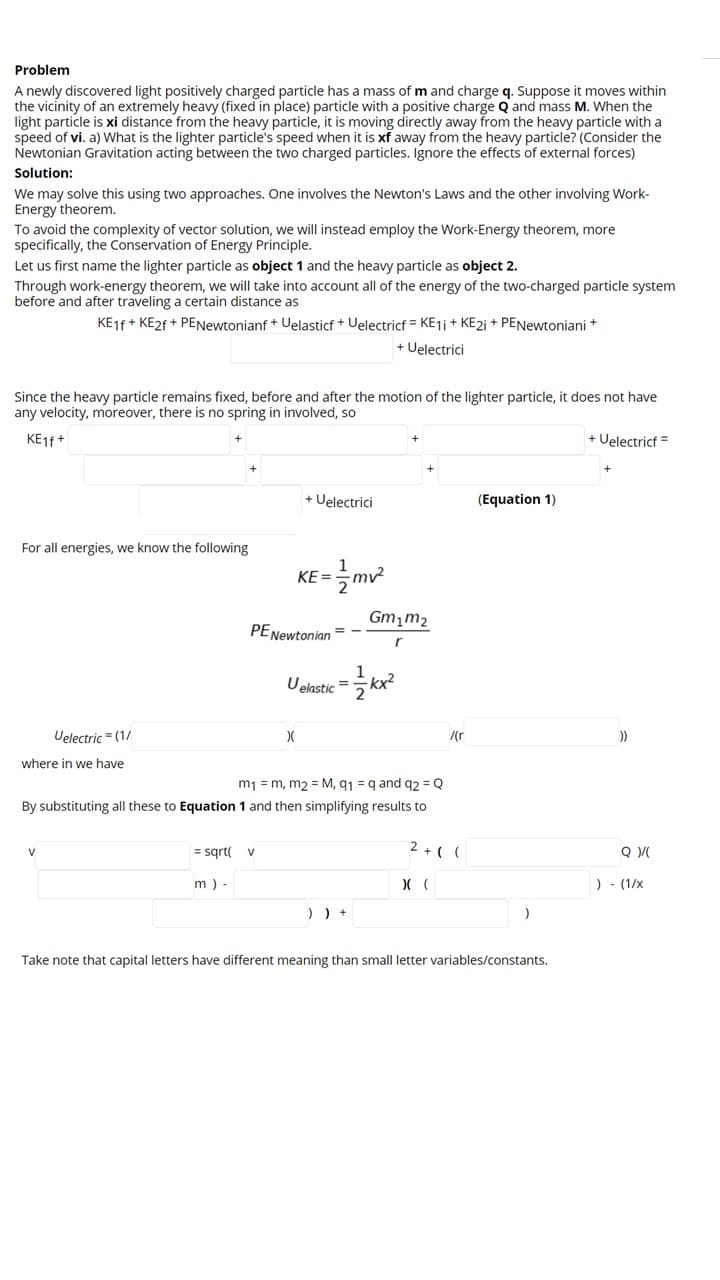ely charged particle has a mass of m and charge q. Suppose it moves within the vicinity of an extremely heavy (fixed in place) particle with a positive charge Q and mass M. When the light particle is xi distance from the heavy particle, it is moving directly away from the heavy particle with a speed of vi. a) What is the lighter particle's speed when it is xf away from the heavy particle? (Consider the Newtonian Gravitation acting between the two charged pa
ely charged particle has a mass of m and charge q. Suppose it moves within the vicinity of an extremely heavy (fixed in place) particle with a positive charge Q and mass M. When the light particle is xi distance from the heavy particle, it is moving directly away from the heavy particle with a speed of vi. a) What is the lighter particle's speed when it is xf away from the heavy particle? (Consider the Newtonian Gravitation acting between the two charged pa
Elements Of Electromagnetics
7th Edition
ISBN:9780190698614
Author:Sadiku, Matthew N. O.
Publisher:Sadiku, Matthew N. O.
ChapterMA: Math Assessment
Section: Chapter Questions
Problem 1.1MA
Related questions
Question
A newly discovered light positively charged particle has a mass of m and charge q. Suppose it moves within the vicinity of an extremely heavy (fixed in place) particle with a positive charge Q and mass M. When the light particle is xi distance from the heavy particle, it is moving directly away from the heavy particle with a speed of vi. a) What is the lighter particle's speed when it is xf away from the heavy particle? (Consider the Newtonian Gravitation acting between the two charged particles. Ignore the effects of external forces)

Transcribed Image Text:Problem
A newly discovered light positively charged particle has a mass of m and charge q. Suppose it moves within
the vicinity of an extremely heavy (fixed in place) particle with a positive charge Q and mass M. When the
light particle is xi distance from the heavy particle, it is moving directly away from the heavy particle with a
speed of vi. a) What is the lighter particle's speed when it is xf away from the heavy particle? (Consider the
Newtonian Gravitation acting between the two charged particles. Ignore the effects of external forces)
Solution:
We may solve this using two approaches. One involves the Newton's Laws and the other involving Work-
Energy theorem.
To avoid the complexity of vector solution, we will instead employ the Work-Energy theorem, more
specifically, the Conservation of Energy Principle.
Let us first name the lighter particle as object 1 and the heavy particle as object 2.
Through work-energy theorem, we will take into account all of the energy of the two-charged particle system
before and after traveling a certain distance as
KE1F + KE2F + PENewtonianf + Uelasticf + Uelectricf = KE1¡ + KE2i + PENewtoniani +
+ Uelectrici
Since the heavy particle remains fixed, before and after the motion of the lighter particle, it does not have
any velocity, moreover, there is no spring in involved, so
KE1f+
+ Uelectricf =
+ Uelectrici
(Equation 1)
For all energies, we know the following
KE =
Gm,m2
PENewtonian
r
Uelastic =
kx?
Uelectric = (1/
/(r
where in we have
m1 = m, m2 = M, q1 = q and q2 = Q
By substituting all these to Equation 1 and then simplifying results to
= sqrt(
2 +( (
Q
V
m ) -
) - (1/x
) ) +
Take note that capital letters have different meaning than small letter variables/constants.
Expert Solution
This question has been solved!
Explore an expertly crafted, step-by-step solution for a thorough understanding of key concepts.
Step by step
Solved in 4 steps

Knowledge Booster
Learn more about
Need a deep-dive on the concept behind this application? Look no further. Learn more about this topic, mechanical-engineering and related others by exploring similar questions and additional content below.Recommended textbooks for you

Elements Of Electromagnetics
Mechanical Engineering
ISBN:
9780190698614
Author:
Sadiku, Matthew N. O.
Publisher:
Oxford University Press

Mechanics of Materials (10th Edition)
Mechanical Engineering
ISBN:
9780134319650
Author:
Russell C. Hibbeler
Publisher:
PEARSON

Thermodynamics: An Engineering Approach
Mechanical Engineering
ISBN:
9781259822674
Author:
Yunus A. Cengel Dr., Michael A. Boles
Publisher:
McGraw-Hill Education

Elements Of Electromagnetics
Mechanical Engineering
ISBN:
9780190698614
Author:
Sadiku, Matthew N. O.
Publisher:
Oxford University Press

Mechanics of Materials (10th Edition)
Mechanical Engineering
ISBN:
9780134319650
Author:
Russell C. Hibbeler
Publisher:
PEARSON

Thermodynamics: An Engineering Approach
Mechanical Engineering
ISBN:
9781259822674
Author:
Yunus A. Cengel Dr., Michael A. Boles
Publisher:
McGraw-Hill Education

Control Systems Engineering
Mechanical Engineering
ISBN:
9781118170519
Author:
Norman S. Nise
Publisher:
WILEY

Mechanics of Materials (MindTap Course List)
Mechanical Engineering
ISBN:
9781337093347
Author:
Barry J. Goodno, James M. Gere
Publisher:
Cengage Learning

Engineering Mechanics: Statics
Mechanical Engineering
ISBN:
9781118807330
Author:
James L. Meriam, L. G. Kraige, J. N. Bolton
Publisher:
WILEY